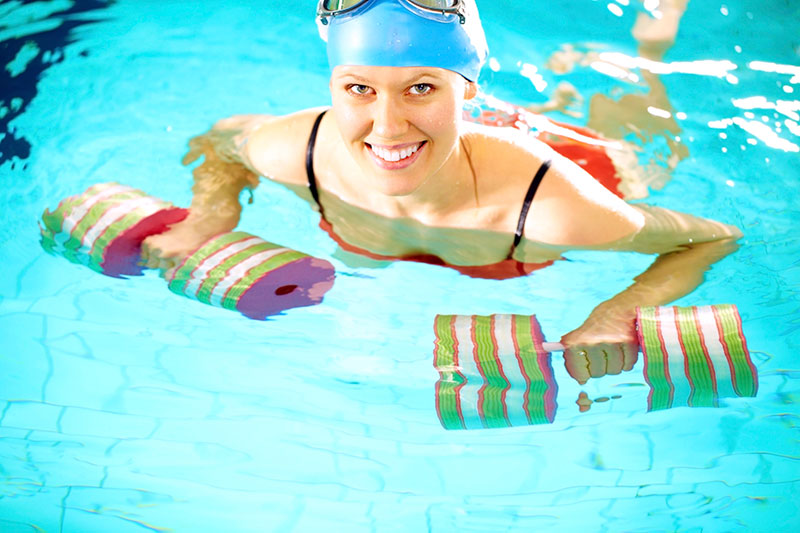All she wanted to do was move.
One year ago, Elaine Abrams underwent total hip replacement set on by aggressive osteoarthritis and degenerative disease. She could barely walk having spent many months in pain. Now she was ready to get back into the gym and resume her active lifestyle.
So her physical therapist put her in the water.
“I tend to push myself, period,” Abrams declares. “But I was able to really speed things up and get more done in the water. I walked on a treadmill, did a whole routine of different exercises, increased my muscle tone.
And now?
“I’m back in the gym everyday,” she says.
Abrams is one of many physical therapy patients benefitting from a “growing number of physical therapists turning to aquatic physical therapy to treat patients with a myriad of health conditions,” according to the American Physical Therapy Association (APTA).
“Aquatic therapy is just that—prescribed exercises performed in a pool as directed by a physical therapist as part of a total treatment plan,” says Mike Satterley, the physical therapist who treated Abrams at the Tidewater Physical Therapy Oyster Point clinic in Newport News, Va. “It’s an effective treatment option that not only helps you physically, but also psychologically.”
We’re not just talking about foam noodles and scissor kicks in the water. In the last decade, the equipment and techniques used to support aquatic therapy have advanced to include paddles, adaptive devices and submerged treadmills, APTA research states.
Therapeutic pools are generally large enough for multiple patients to work out at one time, but small enough to be able to control the temperature. A therapeutic pool is set several degrees higher—usually around 92 degrees—than most swimming pools, but cooler than a hot tub, which is generally set between 100 and 104 degrees.
To be true aquatic therapy, therapists work with the trifecta benefits of water pressure, buoyancy and temperature.
“Where the water makes you lighter, it also safely provides a resistance to movement in every direction, and in a controlled environment,” says Satterley. “We all know it’s harder to walk along the beach in water up to our shins than it is to walk on the sand. That’s the resistance.”
Temperatures ranging from 86 to 94 degrees, Satterley adds, decreases muscle guarding and pain for early therapeutic exercise and can improve range of motion and flexibility.
Some therapy pools also include jets and submerged treadmills.
According to the APTA, water therapy is being used to treat not only patients with total joint replacements, like Abrams, but also children with cerebral palsy, autism, and Down syndrome, and adults with, among other ailments, “joint pain, stiffness, muscle spasms, back pain, osteoarthritis, rheumatoid arthritis, fibromyalgia, lymphedema (and) systemic lupus.”
“Because I’ve been in practice for almost 40 years, I have a large geriatric patient population,” says Dr. Michael Moro of Independence Family Medicine in Virginia Beach, Va. “Aquatic therapy for them can be a godsend.”
Especially, Moro says, for patients with diagnoses like arthritis.
“With aquatic therapy,” he adds, “they can increase their muscle strength without trauma on the joints.”
Satterley agrees.
“Someone with increased levels of arthritis in their legs or back benefits from aquatic therapy because the warm water and buoyancy help to soothe the patient, which makes them more likely to move through larger ranges of motion than they normally would on land,” he says.
Military hospitals are also using aquatic therapy to treat service members, including those recovering from injuries sustained in Iraq and Afghanistan.
Last year, Allison Hoy, a physical therapist at the Walter Reed National Military Medical Center in Bethesda, Md., reported to APTA that aquatic therapy was being used to treat a “special population of polytrauma patients with amputations, limb salvage and/or traumatic brain injury.”
The benefits of aquatic therapy also extends to athletes, where recent clinical studies indicate rehabilitating from injuries in the water could add up to 10 years of participation in a sport to an athlete’s career.
And by athletes, we’re talking about everyone from a professional basketball player to a half-marathon runner.
Patients with an acute lower extremity injury, like an athlete who just sprained their ankle or a runner who has Achilles tendonitis, benefit from aquatic therapy because it allows them to continue moving the way they naturally would in their sport without putting stress or too much weight on the injured area.
“It’s why water aerobics is so popular. That resistance can be used to improve flexibility, strength and endurance of the affected area, preparing for a more safe transition to land-based exercise and overall function.”
Ironically, Satterly says, the “whole goal of using aquatic therapy is actually to get a patient out of the pool. We want them to get strong enough to get back to doing exercises on land; to get back to living their life. Aquatic therapy just helps us get them to that place faster.”







